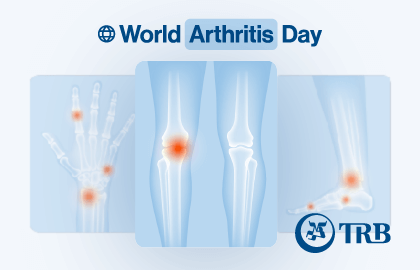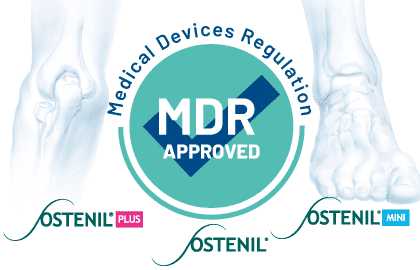
More Than a Day: A Lifelong Commitment to Mobility. World Arthritis Day 2025
On World Arthritis Day, we join millions of patients, caregivers, and healthcare professionals worldwide in raising awareness about this condition that affects quality of life for so many.
At TRB Chemedica, we are committed to supporting both patients living with osteoarthritis and the healthcare professionals who care for them. Through our innovative medical devices and therapeutic solutions, we strive to improve mobility, reduce pain, and enhance quality of life.
Our mission goes beyond treatment. We are proud to stand with the global community in supporting research, education, and dialogue around osteoarthritis – because together, we can make a difference.

Relationship Between Sedentary Lifestyle, Weight Gain, and Osteoarthritis

Osteoarthritis, also called Degenerative Joint Disease, is a severe medical condition when the cartilage between two bones starts to deteriorate. Obesity and a sedentary lifestyle are significant risk factors for osteoarthritis. It is often associated with other pathologies, such as cardiovascular diseases and diabetes. A prospective study has concluded that more than 47% of diabetes type 2 patients also suffer from osteoarthritis. 1
Scroll down to learn more about this painful condition and how to treat it.
What is Osteoarthritis?
The human bones are surrounded by a firm connective tissue known as cartilage. It helps with movement, bending, and other physiology-related activities.
At times, cartilage degenerates faster than usual due to certain controllable or uncontrollable reasons. As a result, the joints become stiff and painful. Osteoarthritis (OA) is the most common type of arthritis in the hips, arms, and knees.
Osteoarthritis is also called a degenerative joint disease (DJD), as the cartilage in some specific areas begins to break down and change to the bone.
Risk Factors for Osteoarthritis
Risk factors for osteoarthritis range from gender, lifestyle, and workload to family history and other genetic conditions. Around 62% of OA cases are found in females. Furthermore, it can be hereditary, since some people are genetically predisposed to cartilage and bone issues.
According to research, postmenopausal women have a higher risk of developing osteoarthritis compared to men of the same age due to a sudden decline in estrogen levels. 2
Below, we have mentioned some common causes of osteoarthritis:
- Age
- Obesity
- History of surgery
- Family history
- Overuse of joints
- Joint malalignment
There is a direct link between osteoarthritis and obesity since obesity increases the likelihood of developing the disease. That’s why knee osteoarthritis in obese women is prevalent, and the risk is four times higher compared to men. 3
Osteoarthritis Symptoms
Osteoarthritis is a painful condition, and its symptoms can directly impact an individual’s life. These patients can experience severe pain and suffer from debilitating symptoms. But the severity of the condition also depends on the affected body part.
For instance, knee osteoarthritis can be more painful and uncomfortable than the one in hand, as the knees support the whole physical structure of a human. 4
Here is a list of symptoms to look out for if you suspect OA:
- Pain in particular body parts, especially knees
- Stiffness in joints
- Tenderness
- Swelling
- Loss of flexibility
- Pain increases after one move or works
- Bone spurs
- Sedentary lifestyle
Osteoarthritis Diagnosis
It’s important to get diagnosed as soon as possible, as osteoarthritis might significantly compromise your quality of life.
Once you visit a physician, they will get X-rays done to observe the level of degeneration and severity of the condition. Alternatively, your doctor can also do an MRI for deeper analysis.
Treatment of Osteoarthritis
Treatment for osteoarthritis begins right after diagnosis and depends on the severity of the condition. The standard treatment that doctors advise is lifestyle changes and weight loss. Getting physically active and maintaining an average body weight can help control OA.
Additionally, pain medications will be prescribed to counter the discomfort and pain the patient experiences. Medicines like OSTENIL, OSTENIL MINI & OSTENIL PLUS help relieve osteoarthritis-induced pain and are highly efficacious in improving the symptoms of osteoarthritis. 5 6 7
An osteoarthritis knee brace is another tool that some doctors advise to deal with stiffness and discomfort.
In rare conditions, osteoarthritis knee surgery is advised by a doctor. It’s a medical procedure aiming at replacing the damaged joint. However, if osteoarthritis has progressed to become severe, then surgery may be imperative.
Conclusion
Many factors increase the risk of OA; however, obesity and a sedentary lifestyle are prominent ones. Maintaining a healthy lifestyle and taking care of your body can help you avoid many diseases in your later years.
Visit TRB to get your hands on world-class pharmaceutical products for treating issues like osteoarthritis.
Endnotes
- Barbour, K. E., Helmick, C. G., Theis, K. A., Murphy, L. B., Hootman, J. M., Brady, T. J., & Cheng, Y. J. (2013). Prevalence of doctor-diagnosed arthritis and arthritis-attributable activity limitation—United States, 2010–2012. Morbidity and mortality weekly report, 62(44), 869.
- Hame, S. L., & Alexander, R. A. (2013). Knee osteoarthritis in women. Current reviews in musculoskeletal medicine, 6(2), 182-187.
- Anderson, J. J., & Felson, D. T. (1988). Factors associated with osteoarthritis of the knee in the first national Health and Nutrition Examination Survey (HANES I) evidence for an association with overweight, race, and physical demands of work. American journal of epidemiology, 128(1), 179-189.
- Allen, K. D., Coffman, C. J., Golightly, Y. M., Stechuchak, K. M., & Keefe, F. J. (2009). Daily pain variations among patients with hand, hip, and knee osteoarthritis. Osteoarthritis and Cartilage, 17(10), 1275-1282.
- Maheu, E., Avouac, B., Dreiser, R. L., & Bardin, T. (2019). A single intra-articular injection of 2.0% non-chemically modified sodium hyaluronate vs 0.8% hylan GF 20 in the treatment of symptomatic knee osteoarthritis: A 6-month, multicenter, randomized, controlled non-inferiority trial. PloS one, 14(12), e0226007.
- Fuchs, S., Erbe, T., Fischer, H. L., & Tibesku, C. O. (2005). Intraarticular hyaluronic acid versus glucocorticoid injections for nonradicular pain in the lumbar spine. Journal of Vascular and Interventional Radiology, 16(11), 1493-1498.
- Tsvetkova ES, Denisov L, Shmidt EI, Ryabitseva O, Anikin S. Efficacy and safety of sodium hyaluronate in hip osteoarthritis. A randomised double-blind, lidocaine-controlled, multicentre study with a 12-month follow-up. Annals of Rheumatic Diseases. 2010;69(Suppl 3):281.

Relationship between Dry Eyes and Hot Weather in GCC

According to a study, almost 2/3rd of UAE residents suffer from dry eye disease or Keratoconjunctivitis Sicca.
The figures may be daunting, but the hot climate, low humidity, and excessive air conditioning cause severe reduction in tear production. The dry eye sensation can interfere with daily activities, necessitating the use of eye drops regularly. It may also cause inflammation and stinging in the eyes that can be reduced with the help of prescription drops.
Read on to learn more about this condition and how it can be treated.
Dry Eye Disease
Gulf countries are facing a growing epidemic of dry eye disease. Typically, this condition occurs during dry weather or in dry environments since both conditions diminish tear film and lubrication around the eyes.
In this condition, your tear ducts do not produce enough tears to keep them lubricated and nourished. Or the tears produced are of poor quality or inadequate to support lubrication. As a result, the eyes become itchy and irritated, leading to severe discomfort.
Since there is insufficient lubrication for the eyes, the vision may also get compromised in most situations, especially while driving. This disease is more prevalent in Gulf countries due to the warm weather and low humidity levels.
Classification of Dry Eye Disease
It is essential to understand that not all forms of dry eye disease are life-limiting. Most people have a mild case of DED, which can be treated easily with organic drops and medication. But, severe cases may require appropriate intervention.
Below we have briefly defined the severity and types of Dry Eyes.
Severity of Dry Eyes:
DED can be categorized into three severity levels:
- MILD
In this case, the patient may have mild conjunctivital signs based on environmental conditions with no corneal signs. Like, extremely dry weather may cause sudden stinging or burning in the eyes. This condition may cause mild or episodic fatigue. Mild cases of dry eyes don’t usually require treatment. However, people should take precautions like avoiding smoky environments and using warm compresses to relieve the symptoms. - MODERATE
Moderate cases may cause epithelial erosion, punctate keratopathy, and filamentary keratitis. This level of DED can lead to episodic symptoms and be somewhat life-limiting. Most moderate and severe cases require anti-inflammatory medications like corticosteroids and cyclosporine A 0.05 %. - SEVERE
Severe DED can possibly be disabling due to constant pain, burning, blurred vision, and itching in the eyes. This can hamper daily life activities making the patient dependent. Artificial tears remain the top option to treat DED. The drops may help relieve the symptoms but don’t aid in curing the condition.
Types of Dry Eyes:
- Evaporative Dry Eye
This condition is caused by inflammation of the Meibomian glands. Consequently, the tears produced evaporate faster than usual due to the damaged lipid layer in your tear film. - Aqueous-Deficient Dry Eye
This type of DED occurs when the lacrimal glands produce low levels of tears’ water component. As a result, the eyes’ surface is not adequately hydrated.
Risk Factors for Dry Eyes
Does hot weather cause dry eyes? Yes, hot and dry weather is one of the primary causes of dry eyes. The hot climate causes the tears to evaporate much quicker, leaving the eyes parched and irritated.
Here are some other risk factors of the DED:
- Age
- Working and living environment
- Screen time
- Contact lens use[1]
Dry Eye Symptoms
According to a study, dry eye is prevalent in older people as they risk losing moisture and lubrication in their eyes.[2]
Here are some symptoms to look out for if you suspect that your eyes are getting irritated and red:
- Redness
- Light sensitivity
- Watery eyes
- Stinging or burning sensation
Early Detection of Dry Eyes
Like every other condition, dry eyes need proper caution and attention to cure. Though dry eyes in a dry climate are not uncommon, any discomfort or pain should be taken seriously. A severe case of DED can end up causing other conditions like eye inflammation, corneal ulcer, or partial blindness.
Treatment of Dry Eye Disease
Simple home remedies for dry eyes include wearing sunglasses and limiting exposure to dry environments. You can also try warm compresses and eyewash to relieve any irritation. These conventional ways may provide temporary relief but won’t be helpful in every case.
Visiting a doctor is imperative if the condition is severe. They will prescribe some eye drops to deal with the issue immediately. According to research, drops containing 0.3% hyaluronic acid improves the overall symptoms of DED.[3]
VISMED GEL contains 0.3% hyaluronic acid and is really efficient in relieving pain caused by dry eyes.
Conclusion
Dry eye symptoms and treatment might not be a medical emergency, but losing the fluid film around the eye sockets can be daunting.
If you live in hot countries like the Gulf countries, take the necessary precautions and incorporate a healthy lifestyle to save your vision.
Besides, visit TRB to get the best eye drops to protect your eyes from dryness, dust, and smog.
[1] Alkabbani, S., Jeyaseelan, L., Rao, A. P., Thakur, S. P., & Warhekar, P. T. (2021). The prevalence, severity, and risk factors for dry eye disease in Dubai–a cross sectional study. BMC ophthalmology, 21(1), 1-7.
[2] Yasir, Z. H., Chauhan, D., Khandekar, R., Souru, C., & Varghese, S. (2019). Prevalence and determinants of dry eye disease among 40 years and older population of Riyadh (except capital), Saudi Arabia. Middle East African Journal of Ophthalmology, 26(1), 27.
[3] You, I. C., Li, Y., Jin, R., Ahn, M., Choi, W., & Yoon, K.C. (2018). Comparison of 0.1%, 0.18%, and 0.3% hyaluronic acid eye drops in the treatment of experimental dry eye. J Ocul Pharmacol Ther, 34(8):557-564.

New European Medical Devices Regulation (MDR)

The new European Medical Devices Regulation (MDR) just came into effect, with immediate application for new medical devices, generating an interesting debate. Some players welcome this major change which will align national regulations, and believe it will help to remove from the market several medical devices with limited evidence and quality control.
Others highlight that the lack of enforcement of the directives in the past rather than the gaps in regulations originated a critical situation and therefore the need for a new MDR. Still others argue that some of the new, more restrictive regulations might be detrimental to innovation. For example, the classification of most medical software has shifted to class IIa or higher, thereby putting many start-ups and medical applications under pressure.
Irrespective of any personal opinion with regard to this regulation, the more demanding reviewing processes are meant to ensure safer and more effective solutions to the patient’s health conditions.
As a non-exhaustive list of the key changes impacting our products and dossiers we can quote:
- Risk classification of devices and scope of the Regulations
- Clinical investigations and performance studies
- Obligations and regulatory requirements of economic operators
- Traceability
- Identification
- Labelling and instructions for use
You will be able to find a more comprehensive overview on the changes in the Factsheet for healthcare professionals and health institutions, published by the European Commission.
As a Swiss pharmaceutical company, it is our duty to meet some of the highest quality standards in the world and stay one step ahead. That is why we have taken a proactive stance towards being MDR compliant. Our OSTENIL® Line, focused on rheumatology and tendinopathy, received MDR approval and new registrations for OSTENIL®, OSTENIL® Plus, OSTENIL® Mini and OSTENIL® Tendon from the 1st semester of 2022.
In a similar fashion, although we still have a few years until the deadline to switch our VISMED® ophthalmology line over to MDR, our regulatory departments are working extensively to make sure our products will be ready for conformity assessments as well as seamlessly available on the European market.
to find out more, visit our product page

We are pleased to announce our presence at CPHI CONGRESS 2022

Every year, CPHI brings together over 100,000 pharmaceutical industry professionals from around the world in physical and online workshops for the purpose of networking and identifying business opportunities. This year’s event is expected to be one of the busiest yet with over 39,000 expected participants.
If you are planning to attend, do not miss the opportunity to visit our stand #41F52.
Please contact our team for more information or to schedule a meeting onsite.

Join us at the European Society of Cataract and Refractive Surgeons Congress

Visit us at the 40th ESCRS Congress in Milan. We look forward to welcoming you at our booth B40 from September 16 to 20, 2022.